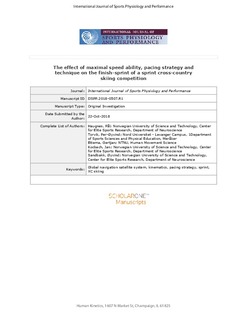| dc.contributor.author | Haugnes, Pål | |
| dc.contributor.author | Torvik, Per Øyvind | |
| dc.contributor.author | Ettema, Gertjan | |
| dc.contributor.author | Kocbach, Jan | |
| dc.contributor.author | Sandbakk, Øyvind | |
| dc.date.accessioned | 2019-04-25T08:23:33Z | |
| dc.date.available | 2019-04-25T08:23:33Z | |
| dc.date.created | 2018-12-31T15:47:06Z | |
| dc.date.issued | 2018 | |
| dc.identifier.issn | 1555-0265 | |
| dc.identifier.uri | http://hdl.handle.net/11250/2595398 | |
| dc.description.abstract | Purpose:
The aims of this study were to investigate the contribution from maximal speed (Vmax) and %Vmax to the finish-sprint speed obtained in a cross-country (XC) sprint in the classical and skating style, as well as the coinciding changes in kinematic patterns, and the effect of pacing strategy on the %Vmax.
Methods:
Twelve elite male XC skiers performed two 80-m Vmax tests on flat terrain using the classical double poling and skating G3 techniques, followed by four simulated 1.4-km sprint time-trials, performed with conservative (controlled start) and positive (hard start) pacing strategies in both styles with a randomized order. In all cases, these time-trials were finalized by sprinting maximally over the last 80-m (the Vmax-section).
Results:
~85% of Vmax was obtained in the finish-sprint of the 1.4-km competitions, with Vmax and %Vmax contributing similarly (R2=51-78%) to explain the overall variance in finish-sprint speed in all four cases (P<0.05). The changes in kinematic pattern from the Vmax to the finish-sprint included 11-22% reduced cycle rate in both styles (P<0.01), without any changes in cycle length. A 3.6% faster finish-sprint speed, explained by higher cycle rate, was found by conservative pacing in classic (P<0.001), whereas no difference was seen in skating.
Conclusions:
The Vmax ability and the %Vmax contributed similarly to explain the finish-sprint speed, both in the classic and skating styles, and independent of pacing strategy. Sprint XC skiers should therefore concurrently develop both these capacities, and employ technical strategies where a high cycle rate can be sustained when fatigue occurs. | nb_NO |
| dc.language.iso | eng | nb_NO |
| dc.publisher | Human Kinetics | nb_NO |
| dc.title | The Effect of Maximal Speed Ability, Pacing Strategy, and Technique on the Finish Sprint of a Sprint Cross-Country Skiing Competition | nb_NO |
| dc.type | Journal article | nb_NO |
| dc.type | Peer reviewed | nb_NO |
| dc.description.version | acceptedVersion | nb_NO |
| dc.source.journal | International Journal of Sports Physiology and Performance | nb_NO |
| dc.identifier.doi | 10.1123/ijspp.2018-0507 | |
| dc.identifier.cristin | 1647946 | |
| dc.relation.project | Norges forskningsråd: 245622 | nb_NO |
| dc.relation.project | Norges forskningsråd: 245625 | nb_NO |
| dc.description.localcode | © 2018. This is the authors' accepted and refereed manuscript to the article. The final authenticated version is available online at: https://doi.org/10.1123/ijspp.2018-0507 | nb_NO |
| cristin.unitcode | 194,65,30,0 | |
| cristin.unitname | Institutt for nevromedisin og bevegelsesvitenskap | |
| cristin.ispublished | false | |
| cristin.fulltext | postprint | |
| cristin.qualitycode | 1 | |
